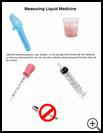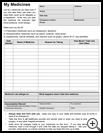
Ondansetron, Oral
on-DAN-se-tron
________________________________________________________________________
KEY POINTS
- This medicine is taken by mouth to prevent nausea and vomiting after surgery, chemotherapy, or radiation therapy. Take it exactly as directed.
- This medicine may cause unwanted side effects. Tell your healthcare provider if you have any side effects that are serious, continue, or get worse.
- This medicine may cause life-threatening problems if you take this medicine with certain other medicines. Tell all healthcare providers who treat you about all the prescription medicines, nonprescription medicines, supplements, natural remedies, and vitamins that you take.
________________________________________________________________________
What are other names for this medicine?
Type of medicine: 5-HT3 receptor antagonist; antiemetic (antinausea)
Generic and brand names: ondansetron, oral; Zofran; Zofran ODT; Zuplenz
What is this medicine used for?
This medicine is given to prevent nausea and vomiting caused by chemotherapy or radiation therapy. It is also given to prevent nausea and vomiting after surgery.
This medicine may be used to treat other conditions as determined by your healthcare provider.
What should my healthcare provider know before I take this medicine?
Before taking this medicine, tell your healthcare provider if you have ever had:
- An allergic reaction to any medicine
- Heart problems
- Liver disease
- Heart problems such as a heart attack, heart failure, or an irregular or slow heartbeat
- Phenylketonuria (PKU). The orally disintegrating tablet contains phenylalanine.
- Long QT syndrome (problems with electrical activity in the heart muscle)
- Too little potassium or magnesium in your blood
- Stomach or digestive problems
Also tell your healthcare provider if you take diuretics (water pills), or medicine to control heart rhythms.
Females of childbearing age: Tell your healthcare provider if you are pregnant or plan to become pregnant. Do not breast-feed while taking this medicine without your healthcare provider's approval.
How do I use it?
Check the label on the medicine for directions about your specific dose. Take this medicine exactly as your healthcare provider prescribes. Ask your healthcare provider or pharmacist about anything you do not understand.
Check the label on the medicine for directions about your specific dose. Take this medicine exactly as your healthcare provider prescribes. Ask your healthcare provider or pharmacist about anything you do not understand.
Check with your healthcare provider before using this medicine in children under age of 4.
This medicine is taken by mouth in the form of a liquid, tablet, film, or disintegrating tablet.
If you are taking the orally disintegrating tablet (ODT), do not remove them from blister pack until needed. Peel the backing off the blister pack. Do not push tablet through the packaging. With dry hands, place the tablet on your tongue and allow it to dissolve in your mouth before swallowing.
If you are taking the liquid form of this medicine, use the measuring spoon, cup, dropper, or oral syringe that comes with the medicine, or ask your pharmacist for one. Do not use a kitchen spoon because the dose may not be correct.
If you take the soluble film, make sure your hands are dry before opening the pouch and removing the film. Use the film right away after you take it from the foil pouch. Place the film on your tongue, and let it dissolve. If you need to take more than one film to reach your prescribed dose, let each film dissolve completely before you take another one. If you are taking this medicine to prevent nausea and vomiting due to chemotherapy, take the medicine 30 minutes before receiving your chemotherapy. If you are taking this medicine to prevent nausea and vomiting due to radiation treatment, take the medicine 1 to 2 hours before receiving your radiation treatment or as instructed by your healthcare provider. Sometimes, additional doses of this medicine are taken during chemotherapy or radiation treatment and for 1 to 2 days after the end of your treatment. Take the medicine as directed by your healthcare provider.
If you are taking this medicine to prevent nausea or vomiting after surgery, take it 1 hour before surgery. Take the exact dose as directed by your healthcare provider.
What if I miss a dose?
If you are taking this medicine before chemotherapy, radiation therapy, or surgery as instructed by your healthcare provider, do not miss a dose. If you miss a dose, take it as soon as you remember. If you are not sure of what to do if you miss a dose, contact your healthcare provider.
If you are taking this medicine on a regularly scheduled basis and you miss a dose, take it as soon as you remember unless it is almost time for the next scheduled dose. In that case, skip the missed dose and take the next one as directed. Do not take double doses. If you are not sure of what to do if you miss a dose, or if you miss more than one dose, contact your healthcare provider.
What if I overdose?
If you or anyone else has intentionally taken too much of this medicine, call 911 or go to the emergency room right away. If you pass out, have seizures, weakness or confusion, or have trouble breathing, call 911. If you think that you or anyone else may have taken too much of this medicine, call the poison control center. Do this even if there are no signs of discomfort or poisoning. The poison control center number is 800-222-1222.
Symptoms of an acute overdose may include: sudden loss of vision; severe constipation; lightheadedness; fainting; fast, slow, or irregular heartbeat.
What should I watch out for?
This medicine may cause a life-threatening problem called serotonin syndrome if you take it with certain other medicines, such as antidepressants, migraine medicines, pain medicines, some cough medicines, and St. John’s wort. Make sure that your providers know ALL of the medicines that you take. Contact your healthcare provider right away if you have:
- Restlessness
- Hallucinations
- Loss of coordination
- Stiff muscles
- Fast heartbeat
- Rapid changes in blood pressure or dizziness
- Increased body temperature, sweating, or flushing
- Nausea
- Vomiting
- Diarrhea
This medicine may make you dizzy or drowsy. Do not drive or operate machinery unless you are fully alert.
Adults over the age of 65 may be at greater risk for side effects. Talk with your healthcare provider about this.
If you need emergency care, surgery, lab tests, or dental work, tell the healthcare provider or dentist you are taking this medicine.
What are the possible side effects?
Along with its needed effects, your medicine may cause some unwanted side effects. Some side effects may be very serious. Some side effects may go away as your body adjusts to the medicine. Tell your healthcare provider if you have any side effects that continue or get worse.
Life-threatening (Report these to your healthcare provider right away. If you cannot reach your healthcare provider right away, get emergency medical care or call 911 for help.): Allergic reaction (hives; itching; rash; trouble breathing; tightness in your chest; swelling of your lips, tongue, and throat).
Serious (Report these to your healthcare provider right away.): Fast, slow, or irregular heartbeat; severe dizziness or fainting; trouble breathing; chest pain; yellowing of your skin or eyes; trouble urinating; severe stomach pain or swelling; severe headache; hallucinations; slurred speech; loss of coordination or unsteadiness; fever; numbness or tingling; vision changes.
Other: Mild headache, mild dizziness, drowsiness, shivering, nausea, vomiting, tiredness, diarrhea, constipation, stomach pain, pain or redness at the spot where the shots or infusions were given.
What products might interact with this medicine?
When you take this medicine with other medicines, it can change the way this or any of the other medicines work. Nonprescription medicines, vitamins, natural remedies, and certain foods may also interact. Using these products together might cause harmful side effects. Talk to your healthcare provider if you are taking:
- Alfuzosin (Uroxatral)
- Anagrelide (Agrylin)
- Antiarrhythmic medicines (to treat irregular heartbeat) such as amiodarone (Cordarone, Pacerone), disopyramide (Norpace), dofetilide (Tikosyn), dronedarone (Multaq), flecainide, procainamide, propafenone (Rythmol), quinidine, and sotalol (Betapace, Sorine)
- Antibiotics such as azithromycin (Zithromax, Zmax), bedaquiline (Sirturo), ciprofloxacin (Cipro), clarithromycin (Biaxin), erythromycin (E.E.S., Ery-Tab, Erythrocin), levofloxacin (Levaquin), linezolid (Zyvox), moxifloxacin (Avelox), ofloxacin, pentamidine (NebuPent, Pentam), rifabutin (Mycobutin), rifampin (Rifadin), rifapentine (Priftin), tedizolid (Sivextro), telavancin (Vibativ), and telithromycin (Ketek)
- Antidepressants such as amitriptyline, amoxapine, buspirone, citalopram (Celexa), clomipramine (Anafranil), desipramine (Norpramin), desvenlafaxine (Pristiq), duloxetine (Cymbalta), escitalopram (Lexapro), fluoxetine (Prozac), fluvoxamine (Luvox), imipramine (Tofranil), mirtazapine (Remeron), nefazodone, nortriptyline (Pamelor), sertraline (Zoloft), trazodone, venlafaxine (Effexor), vilazodone (Viibryd), and vortioxetine (Trintellix)
- Antifungal medicines such as fluconazole (Diflucan), itraconazole (Sporanox), ketoconazole (Nizoral), and voriconazole (Vfend)
- Antipsychotic medicines such as aripiprazole (Abilify), asenapine (Saphris), chlorpromazine, clozapine (Clozaril, FazaClo), haloperidol (Haldol), iloperidone (Fanapt), lithium (Lithobid), paliperidone (Invega), pimozide (Orap), quetiapine (Seroquel), thioridazine, and ziprasidone (Geodon)
- Antiseizure medicines such as carbamazepine (Carbatrol, Epitol, Equetro, Tegretol), oxcarbazepine (Trileptal), phenobarbital, phenytoin (Dilantin, Phenytek), and primidone (Mysoline)
- Apomorphine (Apokyn)
- Cancer medicines such as arsenic trioxide (Trisenox), bortezomib (Velcade), bosutinib (Bosulif), ceritinib (Zykadia), crizotinib (Xalkori), dabrafenib (Tafinlar), dasatinib (Sprycel), daunorubicin (Cerubidine), degarelix (Firmagon), doxorubicin (Doxil), eribulin (Halaven), idarubicin (Idamycin), lapatinib (Tykerb), lenvatinib (Lenvima), nilotinib (Tasigna), osimertinib (Tagrisso), panobinostat (Farydak), pazopanib (Votrient), sorafenib (Nexavar), sunitinib (Sutent), toremifene (Fareston), vandetanib (Caprelsa), and vemurafenib (Zelboraf)
- Cimetidine (Tagamet)
- Dextromethorphan, an ingredient in many cough, cold, or allergy medicines such as Robitussin-DM
- Diuretics (water pills) such as bumetanide, chlorthalidone, furosemide (Lasix), hydrochlorothiazide (Microzide), metolazone (Zaroxolyn), and torsemide (Demadex)
- Donepezil (Aricept)
- Doxepin (Silenor)
- Famotidine (Pepcid)
- Fingolimod (Gilenya)
- HIV medicines such as lopinavir/ritonavir (Kaletra), nevirapine (Viramune), ritonavir (Norvir), and saquinavir (Invirase)
- Malaria medicines such as artemether/lumefantrine (Coartem), chloroquine, mefloquine, primaquine, and quinine
- Mifepristone (Korlym, Mifeprex)
- Migraine medicines such as almotriptan (Axert), dihydroergotamine (D.H.E. 45, Migranal), eletriptan (Relpax), ergotamine (Ergomar), frovatriptan (Frova), naratriptan (Amerge), rizatriptan (Maxalt), sumatriptan (Alsuma, Imitrex, Sumavel), and zolmitriptan (Zomig)
- Milnacipran (Savella)
- Mirabegron (Myrbetriq)
- Natural remedies such as SAMe and St. John’s wort
- Pain medicines such as buprenorphine, codeine, fentanyl (Abstral, Actiq, Duragesic, Fentora, Sublimaze), hydrocodone/acetaminophen (Norco, Vicodin), meperidine (Demerol), methadone (Dolophine, Methadose), morphine (Kadian, MS Contin), oxycodone (OxyContin, Roxicodone), tapentadol (Nucynta), and tramadol (ConZip, Ultram)
- Paroxetine (Brisdelle, Paxil, Pexeva)
- Tetrabenazine (Xenazine)
If you are not sure if your medicines might interact, ask your pharmacist or healthcare provider. Keep a list of all your medicines with you. List all the prescription medicines, nonprescription medicines, supplements, natural remedies, and vitamins that you take. Be sure that you tell all healthcare providers who treat you about all the products you are taking.
Protect this medicine from heat, high humidity, and bright light.
Store the tablets or liquid form of this medicine at room temperature. Keep the container tightly closed.
Store the film form of this medicine at room temperature. Keep the film in the foil pouch until ready to use. Keep the foil pouches in the carton.
This advisory includes selected information only and may not include all side effects of this medicine or interactions with other medicines. Ask your healthcare provider or pharmacist for more information or if you have any questions.
Keep all medicines out of the reach of children.
Do not share medicines with other people.
Last modified: 2016-09-22
Last reviewed: 2016-07-25


